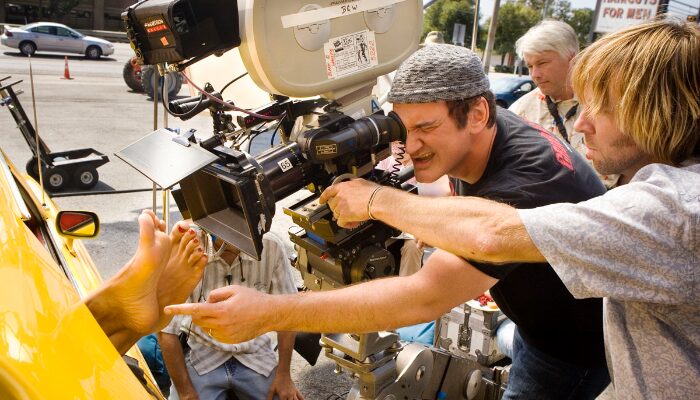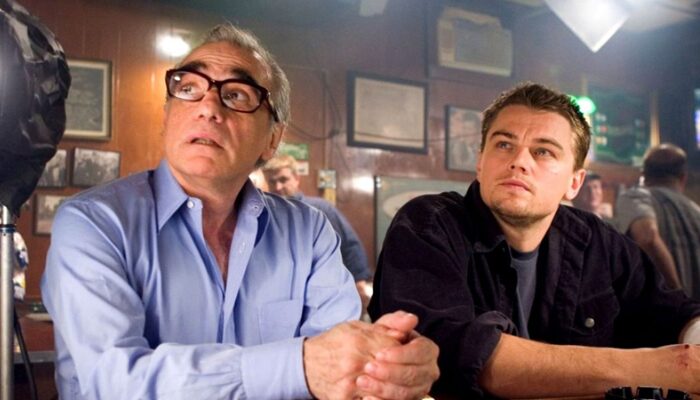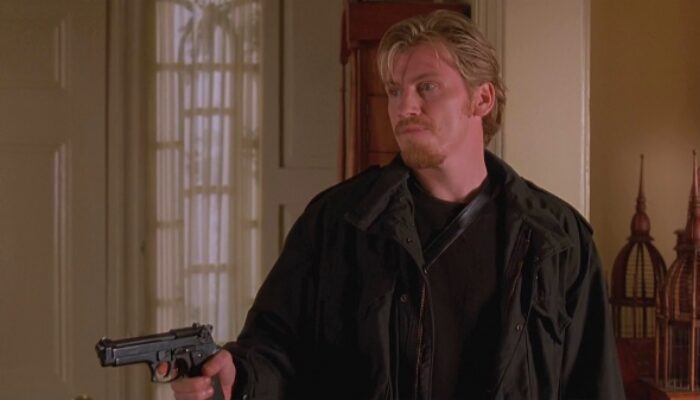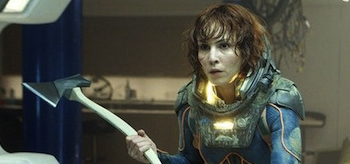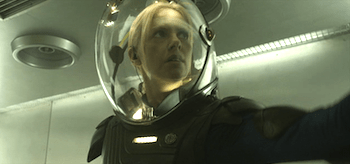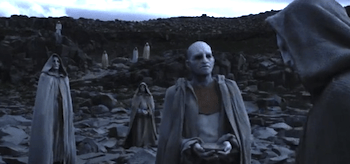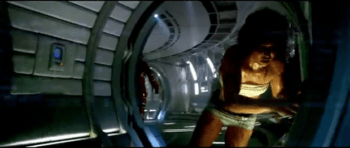Film Review: PROMETHEUS (2012): Ridley Scott, Noomi Rapace
Prometheus (2012) Film Review, a movie directed by Ridley Scott and starring Noomi Rapace, Michael Fassbender, Charlize Theron, Idris Elba, Logan Marshall-Green, Patrick Wilson, Guy Pearce, Rafe Spall, Sean Harris, Kate Dickie, Emun Elliott, Vladimir ‘Furdo’ Furdik, and James Embree.
Prometheus begins with a sacrifice and throughout the course of the film, the viewer is forced to sacrifice their expectations for this film and what it was supposed to represent: a return to good science fiction film making helmed by one of its pioneers, director Ridley Scott.
The film’s ultimate failure is bound to the script written by Jon Spaihts and Damon Lindelof.
The Prometheus script dropped the logic ball many times and it began in its first act with two crew members getting lost. Both crew members had radios on them, GPS (the Prometheus‘ computer was tracking their individual movements) in addition to the fact that they only had to retrace their steps back out of the enclosure. Somehow when everyone else was evacuating, having been warned of an approaching storm, neither of the two crew members heard that communication or any of the communications between the other team members after it. It was an example of a tired, recycled horror movie convention used to isolate and kill off characters countless times before. Jon Spaihts and Damon Lindelof didn’t even bother to make it plausible and/or unique. If they had, they would also have had to have been more creative with other aspects of the script and not rehash old scenarios, trip over quarantine rules, and defy basic captain/ship/crew edict.
When a crew member – Charlie Holloway (Logan Marshall-Green) – comes back to the ship infected, the same scenario in Ridley Scott’s Alien, why would the hanger door to the Prometheus be opened for him and the returning search party? By opening the door, you possibly expose the on-board crew to what Holloway is carrying.
Why does Captain Janek (Idris Elba) try to bring Holloway, infected with God knows what, back onto the Prometheus? Humanity, of course, but he is willing to expose everyone on the ship to what Holloway has. What kind of a captain would be that reckless with the lives under his protection? Then Captain Janek tries to rationalize it with: “We’ll put him in isolation”. Where are the common sense, quarantine protocols? You can’t walk Holloway through the ship to isolation. What if what he is infected with eats through his suit on the way there?
All of these inconsistencies led up to the best scene in the entire film where the brillant mind and eye of Ridley Scott, for a moment, shined through. This scene is also an example of how something was built up in Prometheus then wasted and made logic incoherent, as if scenes had been deleted before and after it (perhaps they were).
The most dramatic scene in Prometheus – a robot performed C-section – begins and ends devoid of reality, a reality it sorely needed to make it that much more impactful and sustain what it had created throughout the remainder of the film. Dan O’Bannon’s Alien script accomplished this feat when Ash went insane and the crew destroyed it, never letting that “not everything is what it appears” feeling dissipate. In Prometheus, the opposite scenario occurs.
The breadcrumbs for the C-section scene were laid in Prometheus‘ first act when the crew was awoken from hyper sleep in the orbit of LV-223.
Later in the film when Elizabeth Shaw (Noomi Rapace) awakens on the table after being knocked unconscious by David (Michael Fassbender), she doesn’t want to be taken to stasis and attacks the people trying to bring her to that area of the ship. She runs all the way to Meredith Vickers (Charlize Theron)’s room and the medical bed there.
Here are the problems with the beginning of this scene: Where was Vickers during all of this? She lets anybody in and out of her private room? The two people that Shaw hit to get out of the medical/examination center do not give chase or look for her? If they did, it was all off screen.
Back to the scene.
The medical sequence that happens in the medical bed room is 95% captivating, the tension in film climbs and is palpable during it. The fact that Shaw wasn’t knocked out for the procedure and that the medical bed didn’t try to knock her out was dubious (since that is the most painless and safest way for a surgery) but it served the drama of the scene.
Here is the problem during the scene: Ridley Scott should not have used CGI for the C-section wound. He should have used physical effects like he did in Alien when the xenomorph burst out of Executive Officer Kane (John Hurt)’s belly or like in the many Thing sequences in John Carpenter’s The Thing.
Back to the scene.
Shaw moving around during of the C-section procedure, the umbilical cord being pulled off the removed “fetus”, and having her stomach stapled back together was almost completely unbelievable (yet splendidly entertaining) even for a film in the future with advanced medical technology (remember The Agent’s back being broken in Joss Whedon‘s Serenity then seeing him walking normally at the end of the film) .
Ridley Scott had the viewer firmly ensnared during the C-section scene and the viewer just goes with it. There is blood everywhere when Shaw gets out of the medical bed.
Shaw hits the decontamination button and the audience believes the organism removed from Shaw’s pelvis has been killed by the released gas. A reasonable assumption since it stops moving.
Here are the problems with the end of this scene: there is a total disconnect between the horror and tension of this scene and the type and nature of the scene that follows it. Also, the entire crew is totally oblivious to what has just occurred. At no point after what happened in the medical bed does Shaw report it to anyone onboard the Prometheus.
David never asks about the fetus yet he sees the staples and Shaw covered in blood.
Vickers doesn’t ever return to her room to find the bloody mess Shaw made yet she had to. It was her room. How could she not?
Later Captain Janek sees Shaw in visible pain and never asks her why she is in pain or what’s causing it. Wouldn’t a Captain want to know why someone is injured on his ship and how that injury occurred?
It was agonizing to watch these gigantic plot holes show up, pulsate, and grow around the finest, most gripping scene in Prometheus. In Danny Boyle’s Sunshine, when a similar moment occurs (not as great though), the ball is never dropped. In Prometheus, the droppings splatter all over the floor before and after the scene ends.
Peter Weyland (Guy Pearce) being onboard the Prometheus should have been a profound reveal in the film but it somehow managed to be the weakest. With his reveal led up to by Shaw’s C-section, everything (the exciting x-factor initiated by the surgery) in the film should have been escalated but it was not. Because of the enormous holes before and after Shaw’s surgery scene coupled with this lukewarm revelation, it was as if a balloon was losing more and more of its buoyancy, its height diminished by what should have been inflating it.
At this point, only an act of God could have saved Prometheus from its plot drudgery and in fact, that act was attempted. One of the main themes from Ridley Scott’s seminal Blade Runner, finding your creator before you die, is present in Prometheus. That search is made a part of Prometheus‘ plotline in the film’s third act.
Death as a theme and physically conversing with God was far more effective in Blade Runner because everything in that film led up to that momentous moment. When that meeting happened in Blade Runner, God and his creation converse almost as equals, both being highly intelligent. In Prometheus, it is a small character arc resolution to an ineffective, third act character reveal. In addition, instead of an intriguing conversation between creator and creation, the creator does not even deign to verbally respond (though its clear he understands all or parts of what was said to him) and destroys instead.
The destruction of Prometheus did not start with this dramatic missed opportunity but it ended with it. After this point, the film has nothing else meaningful to offer the viewer but standard-fare, more deaths, and expensive CGI.
Films, especially science fiction films, are an exercise in escapism. When you take such great pains to make fantasy real like Prometheus did, including scenarios and lapses like the aforementioned are a disservice to the entire endeavor.
What was not a disservice to Prometheus were the David scenes at the beginning of the film, including seeing him view Lawrence of Arabia (“There is nothing in the desert. Man needs something”). Also, the “Engineers” were extremely well animated as were their flashback sequences.
These are the two main examples of how something new and worthy were added to the Alien franchise mythos because of Prometheus, much like Terminator: The Sarah Connor Chronicles added to the mythos of the Terminator franchise. This, in and of itself, makes Prometheus a great conception, in theory, but its realization on-screen almost completely defeats that accomplishment.
Rating: 6/10
Related Articles
FilmBook's Newsletter
Subscribe to FilmBook’s Daily Newsletter for the latest news!


